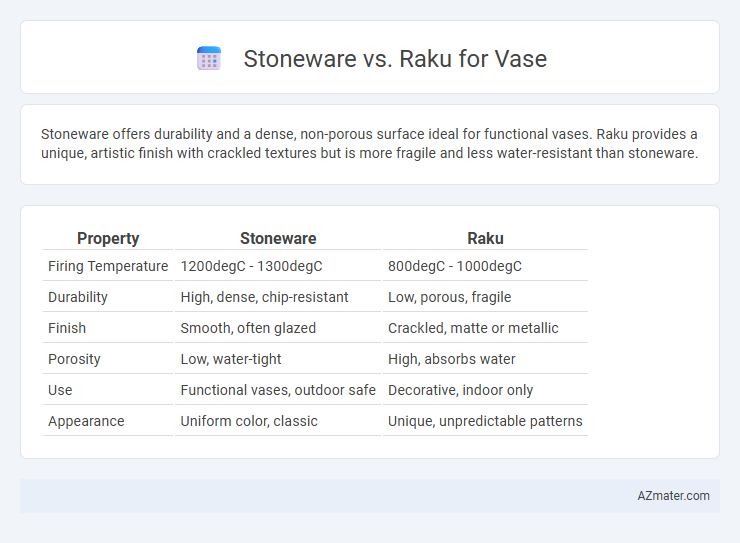Stoneware offers durability and a dense, non-porous surface ideal for functional vases. Raku provides a unique, artistic finish with crackled textures but is more fragile and less water-resistant than stoneware.
Table of Comparison
| Property | Stoneware | Raku |
|---|---|---|
| Firing Temperature | 1200degC - 1300degC | 800degC - 1000degC |
| Durability | High, dense, chip-resistant | Low, porous, fragile |
| Finish | Smooth, often glazed | Crackled, matte or metallic |
| Porosity | Low, water-tight | High, absorbs water |
| Use | Functional vases, outdoor safe | Decorative, indoor only |
| Appearance | Uniform color, classic | Unique, unpredictable patterns |
Introduction to Stoneware and Raku
Stoneware is a dense, durable ceramic fired at high temperatures between 1,200degC and 1,300degC, known for its strength and resistance to water, making it ideal for functional vases. Raku pottery involves a rapid firing process followed by immediate cooling, often producing unique textures and crackled glazes that enhance decorative vases. Both stoneware and raku offer distinct aesthetic and structural qualities, with stoneware providing durability and raku delivering artistic, one-of-a-kind finishes.
Historical Origins of Stoneware and Raku
Stoneware ceramics date back to ancient China around 16th century BCE, known for their durability and dense, non-porous structure created through high-temperature firing between 1,200degC and 1,300degC. Raku pottery originates from 16th century Japan, developed as a method for making tea ceremony vessels, characterized by rapid firing and cooling that produces unique glaze effects and irregular textures. Both techniques embody distinct cultural heritages, with stoneware emphasizing strength and utility, while Raku captures spontaneity and aesthetic imperfection.
Material Composition and Properties
Stoneware vases are made from dense, non-porous clay that is fired at high temperatures between 1,200degC and 1,300degC, resulting in durability, strength, and resistance to chipping. Raku vases are crafted from porous clay bodies fired at lower temperatures, typically around 980degC, and undergo a rapid cooling process that creates unique glazing effects but makes them more fragile and less water-resistant. The material composition of stoneware ensures longevity and practicality for everyday use, while raku's properties emphasize artistic expression and distinctive surface textures.
Firing Temperatures and Techniques
Stoneware vases are fired at high temperatures ranging from 1,200degC to 1,300degC, resulting in a dense, durable, and non-porous ceramic body ideal for functional use. Raku firing involves rapid heating and cooling cycles typically between 1,000degC and 1,020degC, followed by removal from the kiln while red-hot and often subjected to post-firing reduction in combustible materials, producing unique crackled textures and unpredictable surface effects. The controlled high-temperature vitrification of stoneware contrasts with the unpredictable, low-temperature, and smoke-altered finish characteristic of raku ceramics.
Surface Finishes and Glaze Options
Stoneware vases feature dense, durable surfaces with smooth or slightly textured finishes that retain glaze well, offering a wide variety of glossy, matte, and satin glaze options in earth tones and vibrant colors. Raku vases are characterized by their unique, crackled surface textures resulting from rapid cooling during firing, creating unpredictable glaze patterns with metallic sheens and smoky effects often achieved through post-firing reduction techniques. The choice between stoneware and raku for vases depends on the desired aesthetic, with stoneware providing consistent, polished finishes and raku delivering distinctive, rustic artistry with each piece's glaze.
Durability and Functional Uses
Stoneware vases offer superior durability due to their high firing temperatures, making them resistant to chipping, cracking, and water absorption, ideal for everyday functional use. Raku vases, known for their unique aesthetic and porous structure, are more fragile and typically suited for decorative purposes rather than holding water or heavy use. For functional vases requiring long-term durability, stoneware is the preferred choice, while raku excels in artistic and ornamental applications.
Aesthetic Differences in Vase Designs
Stoneware vases exhibit a smooth, often glossy finish with rich, earthy tones and uniform textures that emphasize durability and a refined aesthetic. Raku vases showcase spontaneous crackling patterns and metallic or matte surfaces created through rapid cooling techniques, resulting in unique, organic textures and vibrant color contrasts. The aesthetic difference lies in stoneware's controlled, polished elegance versus Raku's unpredictable, artisan-crafted appearance highlighting natural imperfections.
Suitability for Indoor and Outdoor Use
Stoneware vases offer exceptional durability and water resistance, making them ideal for both indoor and outdoor use. Raku vases, while prized for their unique, artistic finish, are more porous and fragile, limiting their practicality primarily to indoor settings. For outdoor environments, stoneware's robustness ensures longevity against weather conditions, whereas raku requires careful placement to avoid damage.
Cost and Accessibility for Artists
Stoneware vases generally offer a more cost-effective and accessible option for artists due to their widespread availability and moderate firing temperatures, reducing kiln expenses. Raku vases, while prized for their unique textures and rapid firing process, often incur higher costs because of specialized materials and equipment requirements. This makes stoneware preferable for artists seeking economical and versatile clay bodies, whereas raku suits those investing in distinctive, artisanal finishes despite greater initial costs.
Choosing the Best Option for Your Vase
Stoneware vases offer durability, a dense non-porous surface, and a range of earthy glaze finishes ideal for long-lasting indoor or outdoor use. Raku vases provide unique, artistic crackled textures and vibrant firing effects created through rapid cooling, perfect as decorative statement pieces rather than functional vessels. Choosing between stoneware and raku depends on whether durability and practicality or aesthetic uniqueness and artful appeal are your primary priorities.

Infographic: Stoneware vs Raku for Vase
 azmater.com
azmater.com